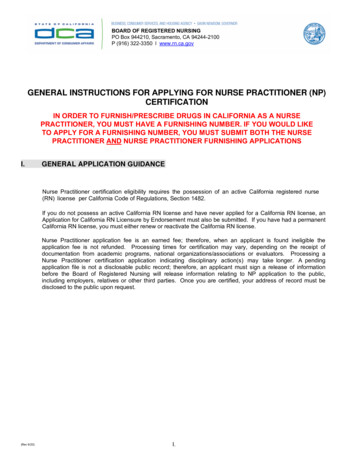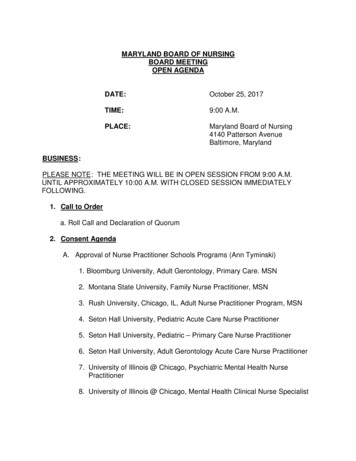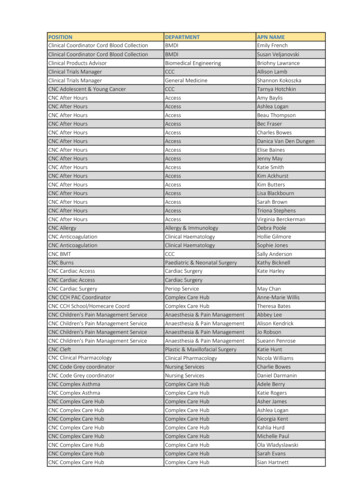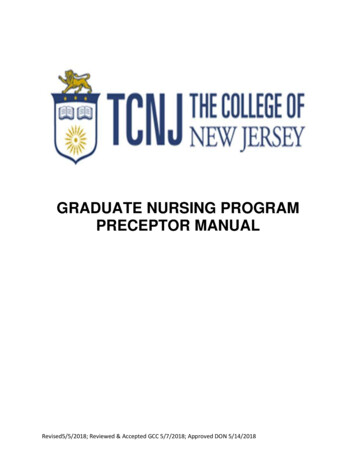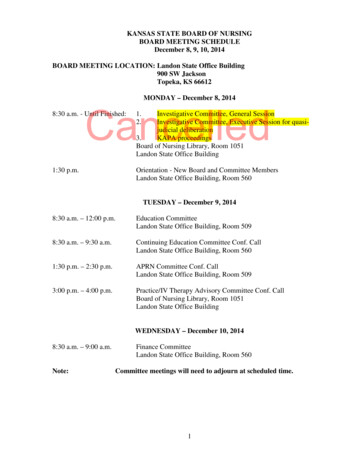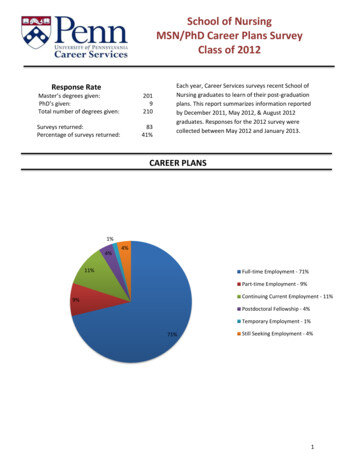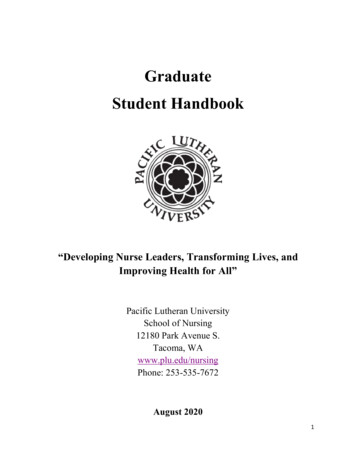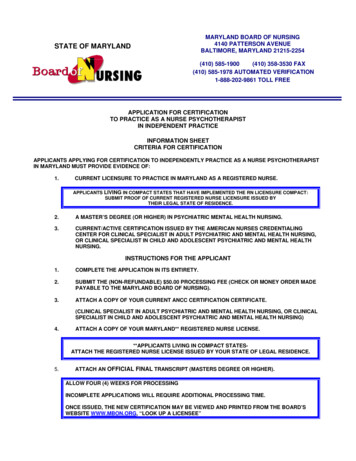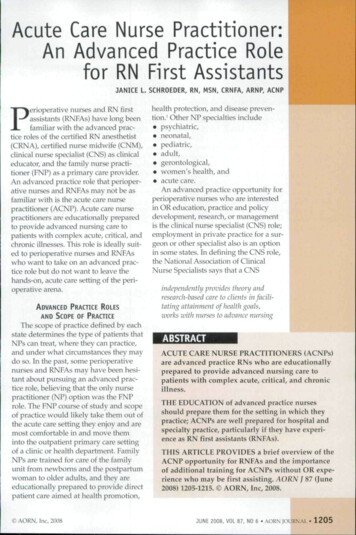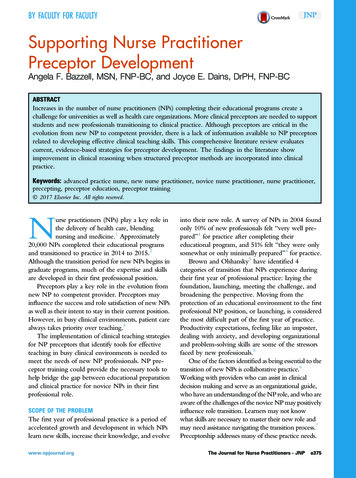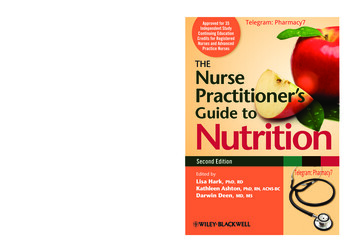
Transcription
The Nurse Practitioner’s Guide to Nutrition, Second Edition is a comprehensive clinicalresource for nurse practitioners working in a variety of clinical care settings.Emphasizing practical nutrition information, this accessible guide providesguidance on incorporating nutrition history questions and counseling techniquesinto routine care across all clinical settings.The book begins by providing fundamental concepts in nutrition during thenursing assessment, giving readers a solid framework from which to approachsubsequent chapters. Section 2 focuses on nutrition from a lifespan perspective,organizing information by the issues most pertinent to patients at different stagesof life. Section 3 presents nutrition counseling across clinical care settings rangingfrom cardiology, endocrinology, oncology, and gastroenterology to caring for theobese patient.Each chapter includes essential information distilled in quick-access tabular formatand clinical scenarios that apply key concepts discussed to real-world examples.Ideal for advanced practice nurses in training and practice, The Nurse Practitioner’sGuide to Nutrition is an essential tool for assessing, managing, and treating nutritionrelated conditions, as well as promoting nutritional health for all patients.This activity has been approved for 35 nursing continuing education contact hoursthrough the Temple University College of Health Professions and Social WorkDepartment of Nursing Provider Unit, an approved provider of continuing nursingeducation by the Pennsylvania State Nurses Association, itself an accredited approverby the American Nurses Credentialing Center’s Commission on Accreditation.Kathleen Ashton, PhD, RN, ACNS-BC, a sought-after speaker and educator, is a Professorof Nursing at Thomas Jefferson University, Jefferson School of Nursing in Philadelphia.Darwin Deen, MD, MS, is a respected nutrition educator of health professionals andco-editor of the Complete Guide to Nutrition in Primary Care. He is also a MedicalProfessor at the Sophie Davis School of Biomedical Education at the City Collegeof New York.SecondEditionHark, Ashtonand DeenLisa Hark, PhD, RD, is a world renowned nutritionist and best-selling author ofnutrition textbooks for health professionals. She is also an Associate Professor atJefferson Medical College in Philadelphia.The Nurse Practitioner’s Guide to NutritionThe Nurse Practitioner’s Guide to Nutrition, Second EditionApproved for 35Independent StudyContinuing EducationCredits for RegisteredNurses and AdvancedPractice NursesTelegram: Pharmacy7TheNursePractitioner’sGuide toNutritionSecond EditionEdited byTelegram: Pharmacy7Lisa Hark, PhD, RDKathleen Ashton, PhD, RN, ACNS-BCDarwin Deen, MD, MSisbn 978-0-4709-6046-29 780470 960462hark 9780470960462 cover2.indd 17/10/12 3:38 PM
Telegram: Pharmacy7
The Nurse Practitioner’s Guide to NutritionSecond EditionTelegram: Pharmacy7
Telegram: Pharmacy7For e-book customersThe Enrolment Form/Answer Sheet and Continuing Education ActivityEvaluation Forms are available for downloading on this website:www.wiley.com/go/hark formsTo access the forms you will be asked for a password, which is the title ofChapter 11: “Renal Care”.The completed forms should be sent, along with 40 and also proof of purchase to:Temple UniversityFrances Ward, PhD, RN, CRNPCollege of Health Professions and Social WorkDepartment of Nursing3307 North Broad StreetPhiladelphia, PA 19140Make check payable to the Temple University Department of Nursing Approvedfor: 35 CE Credit Units Beginning September 1, 2012
The NursePractitioner’sGuide to NutritionEditorsLisa Hark, PhD, RDDirectorDepartment of ResearchWills Eye InstituteAssociate ProfessorJefferson Medical CollegeKathleen Ashton, PhD, RN, ACNS-BCProfessorSchool of NursingThomas Jefferson UniversityDarwin Deen, MD, MSMedical ProfessorSophie Davis School of Biomedical EducationCity College of New YorkSECOND EDITIONA John Wiley & Sons, Inc., PublicationTelegram: Pharmacy7
This edition first published 2012 2012 by John Wiley & Sons, Inc.Wiley-Blackwell is an imprint of John Wiley & Sons, formed by the merger of Wiley’s global Scientific,Technical and Medical business with Blackwell Publishing.Editorial Offices2121 State Avenue, Ames, Iowa 50014-8300, USAThe Atrium, Southern Gate, Chichester, West Sussex, PO19 8SQ, UK9600 Garsington Road, Oxford, OX4 2DQ, UKFor details of our global editorial offices, for customer services and for information about howto apply for permission to reuse the copyright material in this book please see our website atwww.wiley.com/wiley-blackwell.Authorization to photocopy items for internal or personal use, or the internal or personal use of specificclients, is granted by Blackwell Publishing, provided that the base fee is paid directly to the CopyrightClearance Center, 222 Rosewood Drive, Danvers, MA 01923. For those organizations that have beengranted a photocopy license by CCC, a separate system of payments has been arranged. The fee codesfor users of the Transactional Reporting Service are ISBN-13: 978-0-4709-6046-2/2012Designations used by companies to distinguish their products are often claimed as trademarks. All brandnames and product names used in this book are trade names, service marks, trademarks or registeredtrademarks of their respective owners. The publisher is not associated with any product or vendormentioned in this book. This publication is designed to provide accurate and authoritative informationin regard to the subject matter covered. It is sold on the understanding that the publisher is not engagedin rendering professional services. If professional advice or other expert assistance is required, theservices of a competent professional should be sought.Library of Congress Cataloging-in-Publication DataThe nurse practitioner’s guide to nutrition / editors-in-chief, Lisa Hark, Kathleen Ashton,Darwin Deen. – 2nd ed.p. ; cm.Guide to nutritionIncludes bibliographical references and index.ISBN 978-0-470-96046-2 (pbk. : alk. paper)I. Hark, Lisa. II. Ashton, Kathleen. III. Deen, Darwin. IV. Title: Guide to nutrition.[DNLM: 1. Nursing Care. 2. Nursing Assessment. 3. Nutrition Assessment.4. Nutrition Therapy–nursing. 5. Nutritional Physiological Phenomena. WY 100]610.73–dc232012005068A catalogue record for this book is available from the British Library.Cover design by Modern Alchemy LLCSet in 10/12.5pt Minion by SPi Publisher Services, Pondicherry, India12012
ContentsAbout the Editors, viiContributors, ixSection 1 Introduction to Nutrition Concepts, 1Chapter 1 The Role of Nurse Practitioners, 3Kathleen C. AshtonChapter 2 Nutrition Assessment for Nurse Practitioners, 12M. Elayne DeSimone and Lisa HarkChapter 3 Nutrition Counseling for Effective Behavior Change, 31Darwin Deen, Virginia Biddle, and Dara DirhanSection 2 Nutrition During the Lifespan, 43Chapter 4 Nutrition from Pre-conception Through Lactation, 45Amy McKeever, Patricia Digiacomo, Lisa Hark, and Kathleen LarkinsChapter 5 Nutrition from Infancy Through Adolescence, 79Susan Breakell Gresko and Bridget S. SullivanChapter 6 Nutrition for Older Adults, 113Cecilia Borden, Christine Conner, and Lisa HarkSection 3 Nutrition in the Clinical Setting, 135Chapter 7 Obesity and Bariatric Surgery Care, 137Lisa Hark, Darwin Deen, and Dory FerraroChapter 8 Cardiology Care, 160Frances Burke and Lisa Harkv
viContentsChapter 9 Endocrinology Care of the Diabetic Patient, 184Neva White, Rickie Brawer, and Cheryl MarcoChapter 10 Digestive Disorders and Gastrointestinal Care, 207Julie Vanderpool and Beth-Ann NortonChapter 11 Renal Care, 235Jean Stover and Lauren SolomonChapter 12 Cancer Prevention and Oncology Care, 261Tamara B. Kaplan, Maureen Huhmann, and Theresa P. YeoChapter 13 Enteral and Parenteral Nutrition Support, 289Jennifer M. Dolan, Nancy Sceery, and Nancy StonerAppendices, 313Appendix A: Food Sources of Vitamin A, 315Appendix B: Food Sources of Vitamin D, 316Appendix C: Food Sources of Vitamin E, 317Appendix D: Food Sources of Vitamin K, 318Appendix E: Food Sources of Vitamin C, 319Appendix F: Food Sources of Folate, 320Appendix G: Food Sources of Calcium (Dairy), 321Appendix H: Food Sources of Calcium (Non-dairy), 322Appendix I: Food Sources of Sodium, 323Appendix J: Food Sources of Potassium, 324Appendix K: Food Sources of Magnesium, 325Appendix L: Food Sources of Iron, 326Appendix M: Food Sources of Omega-3 Fatty Acids, 327Appendix N: Food Sources of Oxalic Acid, 328Appendix O: Food Sources of Dietary Fiber, 329Appendix P: Food Sources of Purine, 330Appendix Q: Therapeutic Lifestyle changes (TLC) Diet(Low-fat, Low-saturated Fat Diet), 331Appendix R: DASH Diet, 332Appendix S: Dietary Reference Intakes (DRIs): Recommended Intakesfor Individuals, Vitamins, 333Appendix T: Dietary Reference Intakes (DRIs): Recommended Intakesfor Individuals, Elements, 335Review Questions, 339Review Answers, 365Index, 367Enrollment Form/Answer Sheet, 385Continuing Education Activity Evaluation Form, 387
About the EditorsLisa Hark, PhD, RD, is Director of the Department of Research at the Wills EyeInstitute and an Associate Professor at Jefferson Medical College in Philadelphia.She was p reviously Director of Nutrition Education and Prevention Program at theUniversity of Pennsylvania School of Medicine from 1995 to 2009. Dr. Hark hasbroad experience in teaching nutrition to nurse practitioners and medical studentsand is a nationally known nutrition educator. She co-edited four editions of the mostpopular nutrition textbook for medical students, Medical Nutrition and Disease(Wiley-Blackwell), published in 1995, 1999, 2005, and 2009. She also co-edited several other W iley-Blackwell books including: The Complete Guide to Nutrition inPrimary Care in 2006 and Achieving Cultural Competency: A Case-Based Approachto Training Health Professionals in 2009. Dr. Hark is also co-editor of CardiovascularNutrition: Disease Management and Prevention, published by the AmericanAcademy of Nutrition and Dietetics in 2004. In addition, Dr. Hark is the author ofNutrition For Life and The Whole Grain Diet Miracle, published by DorlingKindersley in 2005 and 2007. Aimed at consumers, these books have been translatedinto 15 languages and are available in paperback.Kathleen Ashton, PhD, RN, ACNS-BC holds a Baccalaureate in Nursing from CoeCollege, a Masters in Nursing from the University of Maryland, and a Doctorate inHealth Education from Temple University. She has taught nursing at the undergraduate and graduate levels for over 30 years and currently holds the rank of Professor ofNursing at Thomas Jefferson University, Jefferson School of Nursing in Philadelphia.Dr. Ashton’s area of practice is adult health with a specialty in cardiovascular nursing.Over the past 20 years, she has conducted numerous funded research studies onwomen and heart disease. Dr. Ashton has won local, state, and national awards for herresearch, teaching, advanced nursing practice, and public service, including the 2003New Jersey Governor’s Merit Award for Advanced Nursing Practice. She recentlyserved as a co-editor for the 4th edition of the book, Nursing Malpractice, and regularly reviews for the Journal of Clinical Nursing and the Journal of Legal NurseConsulting.vii
viiiAbout the EditorsDarwin Deen, MD, MS, is a Medical Professor at the Sophie Davis School ofBiomedical Education at the City College of New York. A board certified family physician, Dr. Deen also holds a Masters in Human Nutrition and has been teachingnutrition to health professionals for more than 30 years. He is the author of numerouspapers in peer-reviewed journals and has served as a journal contributing editor andmanuscript reviewer for family medicine and nutrition journals as well as a popularnutrition text. Dr. Deen is co-editor of The Complete Guide to Nutrition in PrimaryCare published by Wiley-Blackwell in 2006 and co-author of Nutrition For Life andThe Whole Grain Diet Miracle, published by Dorling Kindersley in 2005 and 2007.He has also served as associate editor of four editions of Medical Nutrition andDisease (Wiley-Blackwell) and the first edition of Achieving Cultural Competency:A Case-Based Approach to Training Health Professionals (Wiley-Blackwell).
ContributorsEditorsFrances Ward, PhD, RN, CRNPLisa Hark, PhD, RDExecutive DirectorPennsylvania Action CoalitionHarrisburg, PADirector, Department of ResearchWills Eye InstituteAssociate Professor, Jefferson Medical CollegePhiladelphia, PAKathleen Ashton, PhD, RN, ACNS-BCProfessorSchool of NursingThomas Jefferson UniversityPhiladelphia, PADarwin Deen, MD, MSMedical ProfessorSophie Davis School of Biomedical EducationCity College of New YorkNew York, NYAssociate EditorsMichael Clark, CRNP, DRNP, CNLAssistant Professor, Department of NursingCollege of Health Professions and Social WorkTemple UniversityAssistant Director of Nursing ResearchTemple University HospitalPhiladelphia, PACarlene McAleer, RN, MS, MSN, CRNPAssistant Professor, Department of NursingCollege of Health Professions and Social WorkTemple UniversityPhiladelphia, PADiana Orenstein, RD, MsEdClinical DietitianHartford HospitalHartford, CTDavid Weiss, BAResearch ManagerDepartment of ResearchWills Eye InstitutePhiladelphia, PAManaging EditorsDeiana M. Johnson, BSResearch Assistant and Community HealthEducatorDepartment of ResearchWills Eye InstitutePhiladelphia, PABianca Collymore, MSProject ManagerDepartment of ResearchWills Eye InstituteContributorsVirginia Biddle, PhD, RN, PMHNP-BC,CPNP (Counseling)Pediatric Nurse PractitionerFamily Psychiatrist/Mental Health NursePractitionerDepartment of Psychiatry andHuman Behavior, Division of Child andAdolescent PsychiatryThomas Jefferson UniversityJefferson University PhysiciansPhiladelphia, PAix
xContributorsCecilia Borden, EdD, MSN, RN (Elderly)Assistant Professor, School of NursingThomas Jefferson UniversityJefferson College of Health ProfessionsPhiladelphia, PARickie Brawer, PhD, MPH, CHES(Endocrine)Associate Director, Center for Urban HealthAssistant ProfessorDepartment of Family and Community MedicineThomas Jefferson University HospitalPhiladelphia, PAFrances Burke, MS, RD (Cardiology)Clinical DietitianPerelman Center for Advanced MedicineHospital for the University of PennsylvaniaPhiladelphia, PaChristine Conner, MPA-HAS, BSN, RN(Elderly)Director of NursingManor Care Health ServicesSkilled Nursing and Rehabilitation FacilityWalnut Creek, CAM. Elayne DeSimone, PhD, NP-C,FAANP (Assessment)Professor, Department of NursingCollege of Health Professions and Social WorkTemple UniversityPhiladelphia, PaPatricia Digiacomo, MSN, RNC(Pregnancy)Assistant ProfessorCollege of Health Professions and Social WorkTemple UniversityPhiladelphia, PaDara Dirhan, MPH, RD, LDN(Counseling)Dietetic InternCorporate Wellness DietitianPrivate Practice ConsultingPhiladelphia, PAJennifer M. Dolan, MS, RD, CNSC(Nutrition Support)Advanced Clinical Dietitian SpecialistClinical Nutrition Support ServiceHospital of the University of PennsylvaniaPhiladelphia, PaDory Ferraro, MS, APRN-CS(Obesity)Clinical Director of Bariatric ServicesStamford HospitalStamford, CTSusan Breakell Gresko, MSN, CRNP,PNP-BC (Pediatrics)Assistant Professor in NursingDepartment of NursingCollege of Health Professions and SocialWorkTemple UniversityPhiladelphia, PaMaureen Huhmann, DCN, RD, CSO(Oncology)Manager, Clinical SciencesNestle Healthcare NutritionFlorham Park, NJTamara B. Kaplan, MD(Oncology)Neurology ResidentJoint Partners Neurology ResidentProgramMassachusetts General HospitalBrigham and Women’s HospitalBoston, MAKathleen Larkins, MSN, CNS,RNC-OB (Pregnancy)InstructorRoxborough Memorial HospitalSchool of NursingPhiladelphia, PACheryl Marco, RD, LDN, CDE(Endocrine)Clinical Dietitian and Diabetes EducatorDepartment of Medicine, Division ofEndocrinology, Diabetes and MetabolicDiseasesThomas Jefferson UniversityPhiladelphia, PaAmy McKeever, PhD, CRNP(Pregnancy)Women’s Health Nurse PractitionerAssistant Professor in NursingVillanova University,College of NursingVillanova, PA
ContributorsxiBeth-Ann Norton, MS, RN, ANP-BC(Gastrointestinal)Julie Vanderpool, RD, MPH, RN, MSN,ACNP (Gastrointestinal)Nurse ManagerInflammatory Bowel Disease CenterMt. Sinai Medical CenterDivision of Gastroenterology/IBDNew York, NYGI Nurse Practitioner, Registered DietitianNashville Gastroenterology AssociatesNashville, TNNancy Sceery, LD, RD, CNSC(Nutrition Support)Neva White, DNP, MSN, CRNP, CDE(Endocrine)Nutrition Support TeamMassachusetts General HospitalBoston, MADiabetes Nurse PractitionerSenior Health EducatorCenter for Urban HealthThomas Jefferson University HospitalPhiladelphia, PALauren Solomon, MSN, ANP-BC,GNP-BC (Renal)Theresa P. Yeo, PhD, MPH, MSN,AOCNPNephrology Nurse PractitionerHospital of the University of PennsylvaniaDepartment of Renal, Electrolytes, andHypertensionIn conjunction with DaVita DialysisPhiladelphia, PaAssociate Director, Jefferson Pancreas TumorRegistryDepartment of SurgeryThomas Jefferson University HospitalAdjunct Associate ProfessorJefferson School of NursingPhiladelphia, PANancy Stoner, RN, MSN, CNSC(Nutrition Support)Clinical Nurse SpecialistClinical Nutrition Support ServiceHospital of the University of PennsylvaniaPhiladelphia, PaJean Stover, RD, LDN (Renal)Nephrology DietitianHospital of the University of PennsylvaniaDepartment of Renal, Electrolytes, and HypertensionIn conjunction with DaVita DialysisPhiladelphia, PaBridget S. Sullivan, MSN, MS, CRNP,RD (Pediatrics)Pediatric Nurse Practitioner, Registered DietitianMt Airy Pediatrics, LLCPhiladelphia, PaReviewersKellie Smith, EdD, RNAssistant ProfessorSchool of NursingThomas Jefferson UniversityPhiladelphia, PASharon Rainer, MSN, CRNPInstructor, School of NursingThomas Jefferson UniversityPhiladelphia, PAPat Iyer, MSN, RN, LNCCLegal Nurse ConsultantMed League Support ServicesFlemington, NJ
Telegram: Pharmacy7
Section 1Introduction to NutritionConcepts
1The Role of Nurse PractitionersKathleen C. Ashton, PhD, RN, ACNS-BCObjectives Discuss the role of nutrition as a component of practice for Nurse Practitioners. Describe the relationship between nutrition and commonly occurring problems such asobesity. Identify effective methods for integrating concepts of sound nutrition into areas ofpractice for Nurse Practitioners.Nurses have outranked all professions in Gallup’s annual Honesty and Ethics Survey1every year since 1999 (Gallup Poll). This vote of confidence from 81% of Americansparticipating in the survey comes with the responsibility to provide the best care tothose who turn to us for information and advice to prevent disease and maintainhealth. Given this trust for nurses, we play a pivotal role in educating individualsabout nutrition. Research findings demonstrate that consistent, intensive, lifestylebased interventions can effectively reduce the risk of chronic disease.2–4Practitioners cite barriers to providing nutrition and lifestyle counseling such aslack of time, lack of nutrition knowledge and confidence, poor patient adherence,low levels of patient health literacy, and lack of teaching materials.5 A major key isconsistency, addressing the lifestyle changes at every patient encounter where appropriate. The nutrition objectives for Healthy People 2020 state that 75% of primarycare clinician office visits should include nutrition counseling for individuals withdiabetes, hyperlipidemia, and hypertension.6 In addition, it may be difficult to translate nutrition science into practical dietary advice. We created The Nurse Practitioner’sGuide to Nutrition to address many of these barriers and to assist Nurse Practitionersin providing useful nutrition education and interventions to those who most standto benefit.As healthcare practices and regulations change, nursing practices must evolveto keep abreast of those changes. The Patient Protection and Affordable Care Actof 2010 will provide healthcare coverage to an increased number of individuals.This presents an opportunity to address health disparities and provide resources toThe Nurse Practitioner’s Guide to Nutrition, Second Edition. Edited by Lisa Hark, Kathleen Ashtonand Darwin Deen. 2012 John Wiley & Sons, Inc. Published 2012 by John Wiley & Sons, Inc.3
4Section 1 Introduction to Nutrition Conceptsmany for whom this has not previously been a possibility. Partnerships with nursesand other professionals can help to effect change at the individual and communitylevels. In whatever setting Nurse Practitioners are working (outpatient, home-based,hospital, nursing home, or community), whatever the reason for the encounter (acuteproblem vs chronic disease management vs health maintenance), and whatever thepatient’s life-cycle stage, we have the opportunity to improve health outcomes. Forexample, when patients seek care in the office setting, we have an opportunity to identify nutrition-related risks associated with their usual dietary intake. In the hospital, we must ensure that a patient’s diet orders promote restoration of healthwhile minimizing the potential for further deterioration. In nursing homes, where therisk of malnutrition is common, screening and monitoring caloric intake are paramount. Home visits are a unique opportunity to assess how diet and lifestyle information is actually practiced. The community affords opportunities to model healthynutritional choices and impact population health.5When patients present for an acute problem we should assess the potential impactof that problem on their ability to maintain healthy eating and activity patterns andidentify potential nutrition-related problems. Patients seeking health maintenanceneed routine dietary screening and appropriate patient education. Those with identified nutrition-related problems require a plan to address those problems, part ofwhich should include a follow-up visit to initiate and monitor behavior changes.Assessing patients’ readiness to change is a critical component in this process(Chapter 3). Patients being seen for chronic disease follow up may require significantchange to their routine dietary intake and often will benefit from a referral to a registered dietitian for more in-depth dietary counseling.5The Nurse Practitioner’s involvement does not cease with referral to a dietitian, asis the case with referral to any specialist. We must follow-up on the nutrition consult,support the plan, provide on-going guidance, evaluate the patient’s ability to adhere tothe diet, and revise the plan as needed. The overarching goal is establishing an eatingpattern that provides an array of options that incorporate ethnic, cultural, traditional,and personal preferences while considering food cost and availability. Interventionsare indicated across the lifespan. With an infant or toddler, we can teach parents ahealthy eating pattern to help maximize their child’s growth and development whileminimizing the impact of their genetic predisposition for disease (Chapter 4). We canhelp adults to identify their potential disease risk and educate them about eatingproperly to minimize that risk or to maximize wellness. As adults age, metabolismslows and small, nutritionally-dense meals are beneficial to minimize the caloriesconsumed and prevent obesity (Chapter 7). In older adulthood we need to screen fornutrition-related problems which affect ongoing health and address the need for ameal plan designed to mitigate the impact of chronic disease (Chapter 6).5Nutrition for LifeWhat is the best eating pattern for life? How does one sift through all of the recommendations and fads? And of what benefit is the best nutrition advice if it is not followed? The US Dietary Guidelines for Americans, 2010 was updated amid concernfor the growing epidemic of overweight and obese Americans (Table 1-1).7
Chapter 1 The Role of Nurse Practitioners5Table 1-1 Dietary Guidelines for Americans 20107 Key RecommendationsBalancing Calories to Manage Weight Prevent and/or reduce overweight and obesity through improved eating and physical activitybehaviors. Control total calorie intake to manage body weight. For people who are overweight orobese, this will mean consuming fewer calories from foods and beverages. Increase physical activity and reduce time spent in sedentary behaviors. Maintain appropriate calorie balance during each stage of life – childhood, adolescence,adulthood, pregnancy and breastfeeding, and older age.Foods and Food Components to Reduce Reduce daily sodium intake to less than 2300 mg and further reduce intaketo 1500 mg among persons who are 51 and older and those of any age who are AfricanAmerican or have hypertension, diabetes, or chronic kidney disease. The 1500 mgrecommendation applies to about half of the US population, including children, andthe majority of adults. Consume less than 10% of calories from saturated fatty acids by replacing them withmonounsaturated and polyunsaturated fatty acids. Consume less than 300 mg per day of dietary cholesterol. Keep trans fatty acid consumption as low as possible by limiting foods that contain syntheticsources of trans fats, such as partially hydrogenated oils, and by limiting other solid fats. Reduce the intake of calories from solid fats and added sugars. Limit the consumption of foods that contain refined grains, especially refined grain foods thatcontain solid fats, added sugars, and sodium. Consume alcohol, if at all, in moderation – up to one drink per day for women and two drinksper day for men – and only by adults of legal drinking age.Foods and Nutrients to IncreaseIndividuals should meet the following recommendations as part of a healthy eating patternwhile staying within their calorie needs: Increase vegetable and fruit intake. Eat a variety of vegetables, especially dark green, red and orange vegetables and beansand peas. Consume at least half of all grains as whole grains. Increase whole-grain intake by replacingrefined grains with whole grains. Increase intake of fat-free or low-fat milk and milk products, such as milk, yogurt, cheese,or fortified soy beverages. Choose a variety of protein foods, which include seafood, lean meat and poultry, eggs, beansand peas, soy products, and unsalted nuts and seeds. Increase the amount and variety of seafood consumed by choosing seafood in place of somemeat and poultry. Replace protein foods that are higher in solid fats with choices that are lower in solid fats andcalories and/or are sources of oils. Use oils to replace solid fats where possible. Choose foods that provide more potassium, dietary fiber, calcium, and vitamin D, which arenutrients of concern in American diets. These foods include vegetables, fruits, whole grains,and milk and milk products.Recommendations for Specific Population GroupsWomen capable of becoming pregnant: Choose foods that supply heme iron, which is more readily absorbed by the body, additionaliron sources, and enhancers of iron absorption such as vitamin C-rich foods. Consume 400 micrograms (µg) per day of synthetic folic acid (from fortified foods and/orsupplements) in addition to food forms of folate from a varied diet.(Continued )
6Section 1 Introduction to Nutrition ConceptsTable 1-1 (Continued )Women who are pregnant or breastfeeding: Consume 8–12 ounces of seafood per week from a variety of seafood types. Due to their high methyl mercury content, limit white (albacore) tuna to 6 ounces per weekand do not eat the following four types of fish: tilefish, shark, swordfish, and king mackerel. Take an iron supplement, as recommended by your health care provider.Individuals Ages 50 Years and Older: Consume foods fortified with vitamin B12, such as fortified cereals, or dietary supplements.Building Healthy Eating Patterns Select an eating pattern that meets nutrient needs over time at an appropriate calorie level. Account for all foods and beverages consumed and assess how they fit within a total healthyeating pattern. Follow food safety recommendations when preparing and eating foods to reduce the risk offood-borne illnesses.Source: Dietary Guidelines for Americans 2011.Approximately one-third of American adults are obese and 72% of men and 64% ofwomen are overweight or obese.8Despite the fact that patients accept the old adage “You are what you eat”, they donot seem able to apply this to their day-to-day dietary intake.5 While many of ourpatients recognize how important it is to “eat right and exercise”, a study from the PewResearch Center found that Americans see weight problems everywhere but in themirror. According to this report, 90% of American adults say most of their fellowAmericans are overweight, but only 70% say this about “the people they know”, and40% say they themselves are overweight.9Approximately 75% of adults are not eating enough fruits and vegetables.10 Ourculture supports convenience, our policies favor junk food, our restaurants have hugeportion sizes to increase the perception of value, and our TV viewing habits demonstrate avoidance of exercise. Convenience foods, ever more popular, are typically nothealthy choices. When attempting to counsel a patient about nutrition, the NursePractitioner faces the barriers of time, money, taste preference, culture, family, andhabit. Health is unfortunately far down on the list of factors that are considered whenfood choices are made.5The typical American diet is too high in calories, sugar, saturated fat, and salt, andlimited in fruits, vegetables, and low-fat dairy foods. Fewer than 25% of Americansget five servings of fruits and vegetables daily. Even among children, calcium intake isinadequate in almost half of 3–5 year olds, and 70% of 12–19 year olds.11 Whether it isthe phosphates in soda that may leach out calcium or the displacement of dairyintake, many teens are losing calcium instead of storing it up during this critical timefor building strong bones. Osteoporosis later in life is
The Nurse Practitioner's Guide to Nutrition, . She was previously Director of Nutrition Education and Prevention Program at the University of Pennsylvania School of Medicine from 1995 to 2009. Dr. Hark has broad experience in teaching nutrition to nurse practitioners and medical students and is a nationally known nutrition educator. She co-edited four editions of the most popular nutrition .


